200 Years of a German Shipping Family
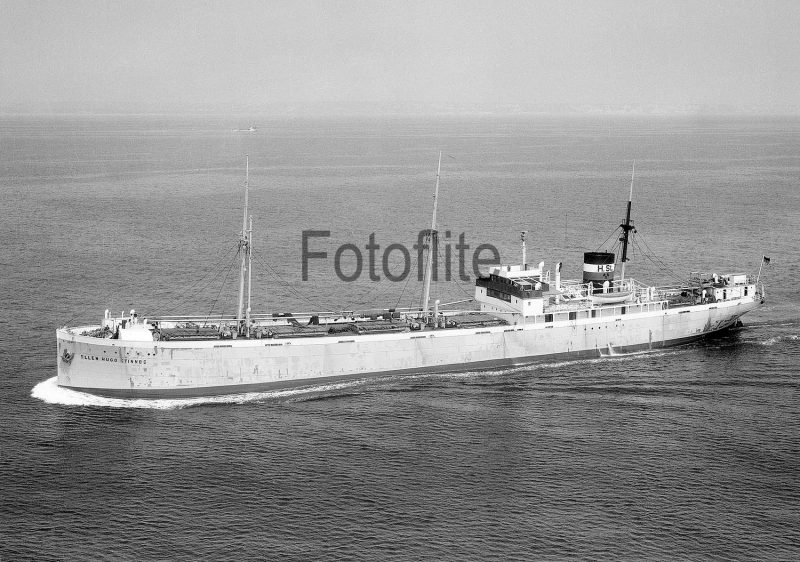
Hugo Dieter Stinnes (1870-1924) was an ambitious, dynamic but controversial entrepreneur, who went on to found the biggest business empire in Germany by the time of his death, covering shipping, coal, coke, gas, electricity, fuel briquettes, iron and steel, chemical, metallurgical and pharmaceutical industries. He entered into partnerships with the other great names in German industry e.g. Thyssen, Krupp, Kirdorf and Siemens. He was by no means just a shipowner, but also the controller of over 1,600 companies and subsidiaries and the employer of over 60,000 workers. He was also a member of the Reichstag Parliament of the Weimar Republic (1919-1933) and had far reaching political and business influence, and used his wealth to change the industrial infrastructure of Germany.
History Of The Stinnes Family And Businesses
Mathias Stinnes (1790-1845) founded a coal mine and barge shipping business on the Ruhr and Rhine rivers in 1808 at Mulheim near Duisburg. The barge fleet eventually numbered over sixty barges and over twenty tugs, which was taken over on his death by his son Hermann Hugo Stinnes, and by his grandson Hugo Dieter Stinnes in 1890. Hugo Dieter Stinnes passed his graduation examinations and worked in an office at Koblenz where he received basic business training. He then worked for a few months as a miner at Wiethe Colliery, and a year later in 1889 he attended a course at the Academy of Mining in Berlin and a year later inherited his father’s coal and barge businesses at the age of twenty years. However, Hugo Dieter Stinnes was dissatisfied with the traditional family business of operating barges, tugs, five coal mines and associated storage facilities, and immediately persuaded his mother to sell her ownership in the firm and lend him 50,000 gold marks to start his own business in 1892. He, however, retained technical management of the Mathias Stinnes A.G. mines, and later his many businesses eventually merged with the Mathias Stinnes A.G. businesses.
In the first decade of the new century, Hugo Dieter Stinnes expanded his own mining interests in Westphalia, the Rhine and Luxembourg areas, and in 1907 turned his attention away from river and coastal shipping to founding a deep sea shipping fleet as Hugo Stinnes Schiffahrt Ges. A fleet of thirteen colliers and tramps was ordered from German yards such as Bremer Vulkan for transatlantic trading to the U.S.A. and Canada as well as to traditional European countries with export coal from Germany. Two ‘three island’ tramps of 8,000 dwt were completed in 1910 as Clare Hugo Stinnes and Nora Hugo Stinnes on dimensions of 385.9 feet in length, moulded beam of 51.6 feet and depth of 26.8 feet, with a fo’c’stle of length 29 feet, bridge deck of 71 feet and poop deck of length 61 feet. Eleven colliers ranging from 2,500 to 4,500 dwt were also completed as Adeline Hugo Stinnes, Annie Hugo Stinnes, Dora Hugo Stinnes, Edmund Hugo Stinnes, Ernst Hugo Stinnes, Fritz Hugo Stinnes, Grete Hugo Stinnes, Heinrich Hugo Stinnes, Helene Hugo Stinnes, Hilde Hugo Stinnes and Otto Hugo Stinnes. English coal was also imported in large quantities via an agency office in Newcastle, and branch offices were set up at Rotterdam and Hamburg with a Head Office in Mulheim. The coal was used partly to drive turbines for the electricity production of the RWE power company on the Rhine, becoming a majority shareholder in RWE along with German steel magnate, Fritz Thyssen. He experimented with using gas burnt off from coke to recycle it for industrial use.
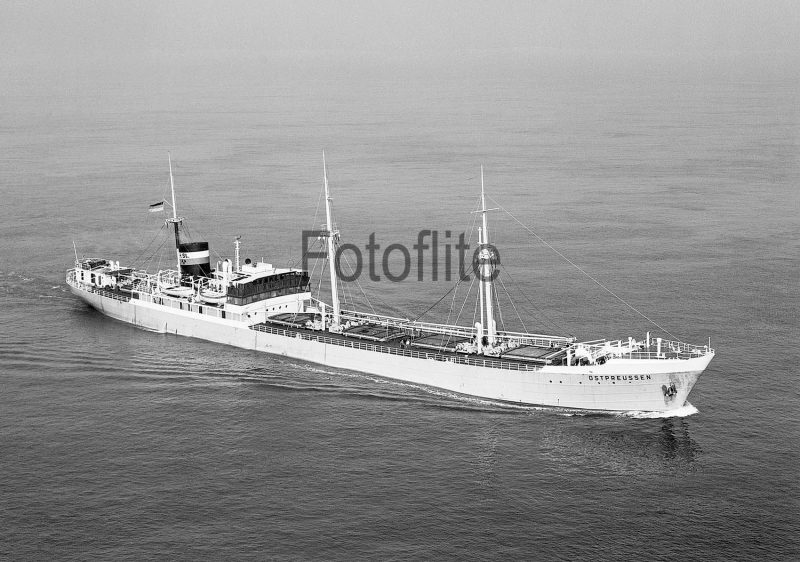
Hugo Dieter Stinnes had married Clare Wagenknecht on 15th June 1895, the daughter of merchant Edmund Karl Wagenknech. His wife had been born at Montevideo on 26th November 1872 while her father was temporarily working in the Uruguayan capital. After her marriage to Hugo Dieter Stinnes, the couple had seven children in Edmund (1896-1980), Hugo Hermann (1897-1982), Clarenore (1901-1990), Otto (1903-1982), Hilde (1904-1975), Ernst (1911-1986) and Else (1913-1897). These family names were to be repeated time and again in the names of ships owned by the many family shipping companies and subsidiaries.
Clare Stinnes (nee Wagenknecht) was to have a very long and busy life, for she lived to attain one hundred years of age, dying at Mulheim on 17th January 1973. After the death of her husband on 10th April 1924 at the early age of 54 years, she became Managing Director of the huge business empire of Hugo Stinnes Gmbh, and until a few years before her death she played an active part as the head of the shipping, coal, industrial and banking enterprises.
During World War I, there were shortages of coal and basic materials needed for normal existence in Germany, and as a consequence the Hugo Dieter Stinnes collier and tramping fleet made great profits. Some ships were lost but the survivors continued in the coastal trades after the end of the war. The Stinnes business interests in England and Holland were sequestrated by the Allies. Undaunted, the ambitions of their owner became apparent in 1916 as he wanted to not only compete with Hapag and Hamburg Sud on their worldwide services, but also if possible take them over. In 1916, he purchased the Woermann shipping business of Hamburg and their associated East African companies, and also purchased the biggest fleet operating out of Flensburg. He then ordered a very large fleet of passenger and cargo-liners, tramps and colliers in 1917 from German yards for completion after the end of the war. A very large fleet of two dozen ships was being operated from 1921 by Hugo Dieter Stinnes under a wide range of shipping, coal, and chemical company names.
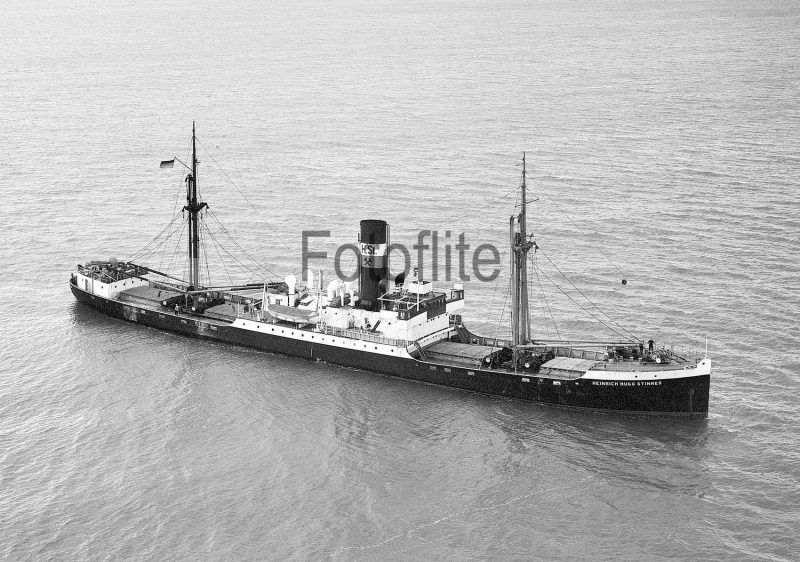
Inter-War Years
The first Stinnes Transatlantic and Far East liner passenger and cargo services were established in 1921 by the ‘Artus’ Danziger Reederei. Hugo Dieter Stinnes had cleverly circumnavigated the strict Allied restrictions of only coastal German shipping being allowed, after these restrictions were imposed at the end of the war, by grasping an opportunity to operate from the free trade port of Danzig to the Caribbean, Central America and the east coast of South America, as well as to the Far East in competition on the same routes operated by Hapag. The ‘Artus’ company funnel colours were blue and yellow, and quite different from the usual Hugo Stinnes colours of black, red and white. Six large six hold cargo ships with four masts were delivered by the Bremer Vulkan and Flensburger yards from 1921 onwards, the first being Artus 7,879/21. She was followed by her sisters Ludendorf 7,892/22, Havenstein 7,973/21, Oliva 7,885/21, Hindenburg 7,880/21 and Tirpitz 7,970/21.
Big six hold, four masted cargo ships were also purchased second hand, such as Badenia 7,441/02 built by Furness, Withy & Co. Ltd. at West Hartlepool and purchased in 1921 and renamed Holm. The steamer Danzig 2,977/21, completed by the Nordseewerke yard at Emden, was however ceded to the British Government and sold on to Mitchell, Cotts & Co. Ltd. and renamed Sunhaven. Danzig (2) 3,217/02 was purchased later in 1921 after being renamed from her original name of Therapia of Norddeutscher Lloyd. More large cargo ships were completed from the Wilhelmshaven yard as Carl Legien 5,707/22, Emil Kirdorf 5,695/22 and Adolf von Baeyer 5,708/23, and the second hand steamer Scheer 8,142/15 was purchased and renamed at this time after completion in 1915 as Kronenfels for Hansa Line, as well as three steamers purchased from Axel Johnson of Sweden.
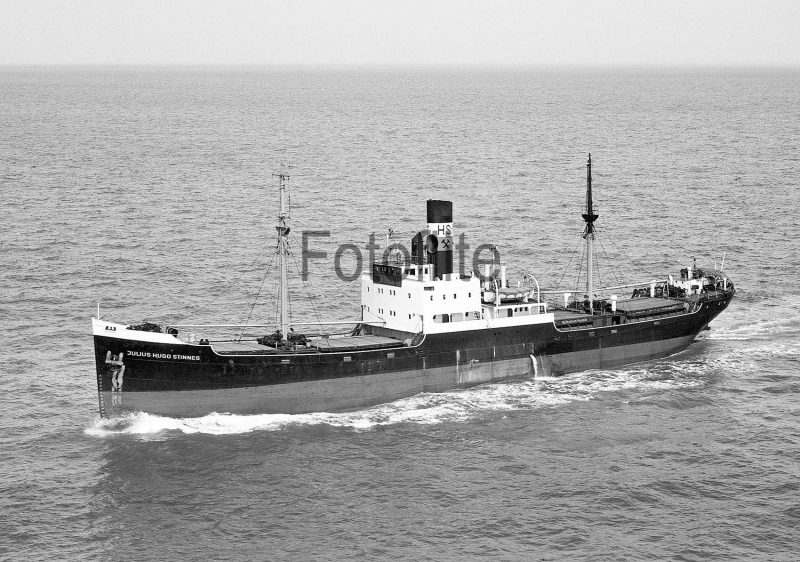
The passenger side of the ‘Artus’ Danziger Reederei Transatlantic service of Stinnes was provided by the passenger liner General Belgrano 10,056/13, which had been commissioned as the twin screw Bahia Castillo for Hamburg Sud. She was surrendered to Britain in 1919, and was purchased by Stinnes in September 1922, who renamed her initially as General San Martin, later renamed General Belgrano. She had accommodation for 700 passengers in First Class, 202 in Second Class, as well as steerage passengers in the holds if no cargo was being carried.
The ports served by the Caribbean, Central American and East Coast of South America by Stinnes were Danzig, Hamburg, Antwerp, La Coruna (or Villagarcia or Vigo), Leixoes, Lisbon, Madeira, Pernambuco, Bahia, Vitoria, Rio de Janeiro, Santos, Montevideo and Buenos Aires. The ports served by the Far East services of Stinnes were Danzig, Hamburg, Rotterdam, Naples, Port Said, Colombo, Singapore, Miri, Hong Kong, Shanghai, Moji, Kobe, and Yokohama. In 1921, Stinnes also participated in the Ocean Line of H. Schuldt Shipping of Hamburg with fruit services from Cuban and Caribbean ports in ships with names ending in ‘burg’ e.g. Aldenburg.
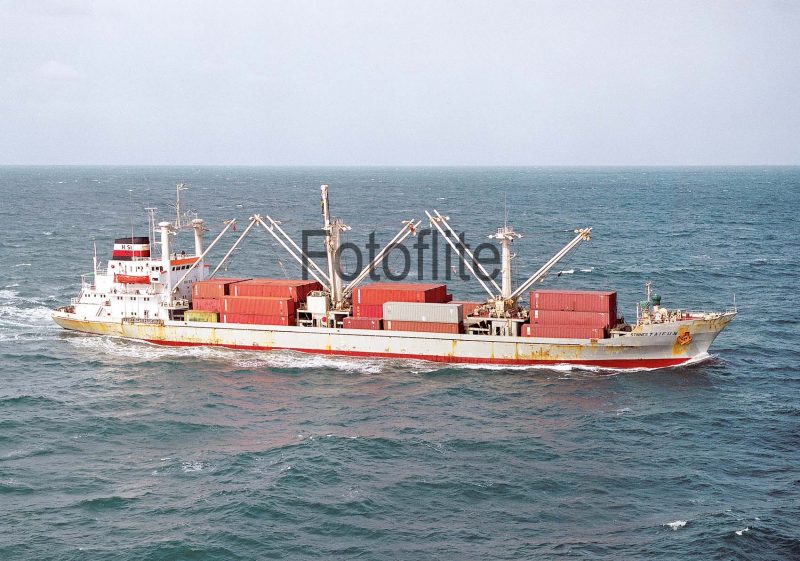
On his deathbed in Berlin on 10th April 1924 as the result of complications from a gall bladder operation, Hugo Dieter Stinnes owned a colossal industrial empire of 1,600 companies and subsidiaries with 60,000 workers, as well as 81 coal mines, 56 steel rolling mills, and two dozen passenger, cargo-liner, tramp and collier ships. The two eldest sons, Hugo Junior and Edmund Stinnes, were given the job of consolidating and rationalising this colossal empire. However, instead of collaborating with each other they competed against each other in the many Stinnes industries, racking up huge debts in the process. Eighteen months after the death of their father, the Stinnes business empire lay in ruins with the German banks calling in their loans, and huge debts of 90 million deutschmarks had been built up. In order to save the last of his inheritance, Hugo Junior established ties with American banks, securing a loan of 100 million deutschmarks. He retained only half of this sum, as the American banks insisted on his assets being transferred to the newly founded Hugo Stinnes Corporation with a headquarter office in Baltimore. Thus, the Stinnes industrial empire fortune had moved from Germany to the U.S.A., which seized the assets in 1943 during World War II as being enemy property. The Stinnes family was then excluded from the management of their American assets until June 1948. The entire fleet of the ‘Artus’ Danziger Reederei of Stinnes was taken over initially by the Deutsche Australien Line and Kosmos Line, and then by Hapag on 24th November 1926, with the fleet continuing on the same services to South American ports and the River Plate but under Hapag colours.
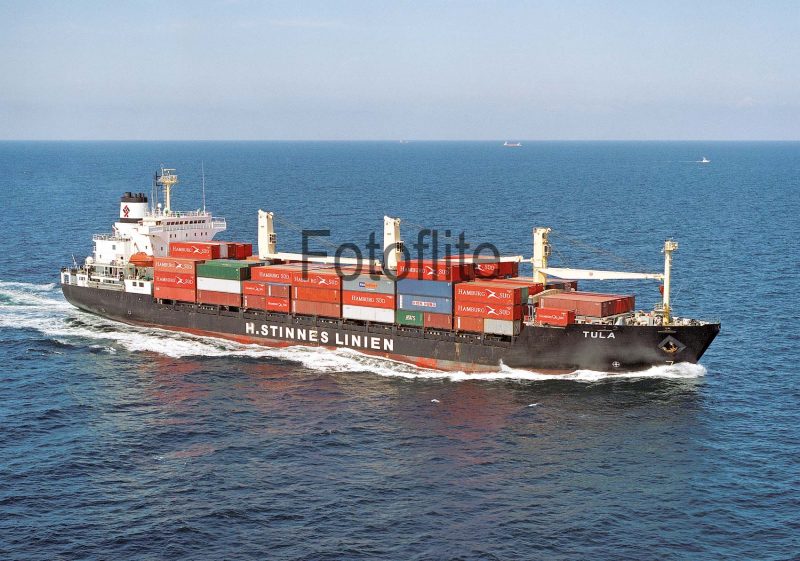
The Poseidon Line (Poseidon Schiffahrt Gmbh) was founded in 1920 jointly by Hugo Dieter Stinnes and the German Coal Depot (Deutsche Kohlen Depot). Hugo Dieter Stinnes wanted to ship Ruhr coal to East Germany after World War I, as well as supply his two pulp mills in Koningsberg, now Kaliningrad. He accordingly took over a greater part of the German coal industry in May 1919. The German Coal Depot fleet in 1920 consisted of the collier Kohlenimport of 1,500 dwt and the motor coaster Charlotte of 600 dwt. This was expanded as part of Poseidon Line, and included the collier Koholyt of 1,200 dwt and completed in 1920. The Koholyt Trading and Shipping Gmbh A.G. was also established by Hugo Dieter Stinnes in 1920 by combining several German coal companies, the name being derived as an abbreviation of the words Kohle (Coal), Holz (wood) and Elektrolyt (electrolyte).
The Poseidon Line expanded its collier fleet rapidly to ten colliers by 1930, including the twin screw Allenstein, Fritz Schoop, Insterburg, Koholyt, Koningsberg Preussen (3,650 dwt), Marienburg, Ostpreussen (5,430 dwt), Poseidon, Rheinland (4,225 dwt) and Tilsit. Poseidon was the largest vessel in the fleet at 6,238 dwt and had been built in 1918 at Zaandam as Nieuwe Maas. The collier Felix Heumann of 4,075 dwt then joined the Poseidon fleet, as well as the new collier Masuren of 3,500 dwt in 1935 from the Schichau yard and powered by triple expansion steam reciprocating machinery and an exhaust turbine. The Hugo Stinnes Gmbh collier fleet was also expanded after the collapse of the Stinnes financial empire by the injection of new capital, with new colliers in 1927/28 in Else Hugo Stinnes and Ernst Hugo Stinnes of 5,000 dwt, as well as the earlier Annie Hugo Stinnes, Dieter Hugo Stinnes, Edmund Hugo Stinnes and Julius Hugo Stinnes. In 1934, the shipping departments of Mathias Stinnes Gmbh and Hugo Stinnes Gmbh were merged into the United Stinnes Rhine Shipping Company established in and operating from Mulheim.
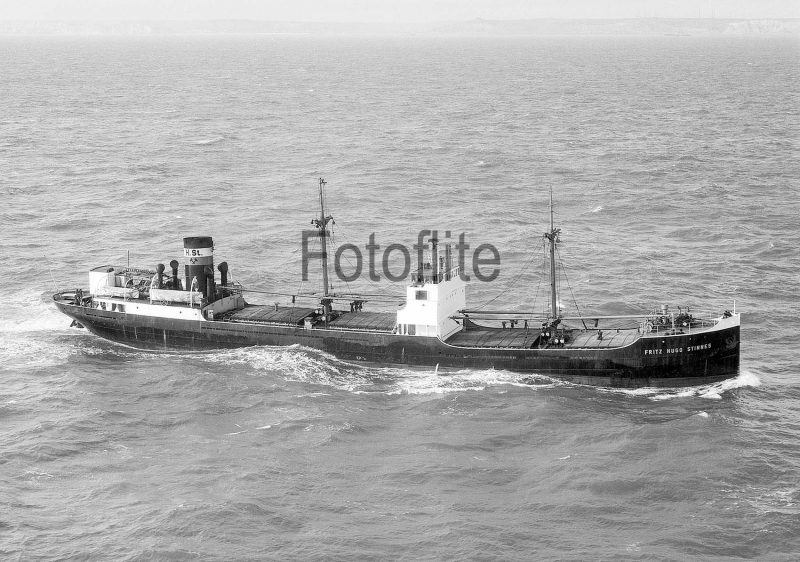
The Transocean Coal and Transportation Corporation of New York was established as a Stinnes subsidiary for the import of German anthracite coal into Canada in 1935. This company was a successor company to the Iroquois Fuel and Coal Co. Ltd. of Montreal, with 50,000 tonnes of German anthracite imported into Canada in 1935, a figure that increased rapidly by 1939. A new sextet of handsome engines ‘midships Stinnes motortramps was completed between 1935 and 1939, with four on charter to the Transocean Coal and Transportation Corporation for the import of German anthracite into Canada with the return cargo being cotton loaded at Galveston, Houston or New Orleans in the U.S. Gulf. These four were completed as Clare Hugo Stinnes, Johannes Molkenbuhr, Welheim and Flensburg, with the two remaining sisters, Mathias Stinnes and Mulheim-Ruhr, completed for the ownership of the ‘Brenntag’ Bernstoff Chemical and Transport K.G. for charter carrying ores. The ‘Brenntag’ company was, and still is, the largest distributor of chemicals in Europe, and was purchased in 1938 by Stinnes as a subsidiary of Stinnes A.G. with eighty distribution centres in Europe and fifty in the U.S.A., with the German Head Office in Mulheim. This sextet of 8,000 dwt motor tramps were all completed at Flensburg on dimensions of 443.0 feet length, moulded beam of 60.3 feet, and draft of 24.0 feet, with eight electric cranes serving their four hatches and a service speed of 14 knots from twin eight cylinder M.A.N. oil engines of 4,600 bhp through single reduction gearing to a single screw.
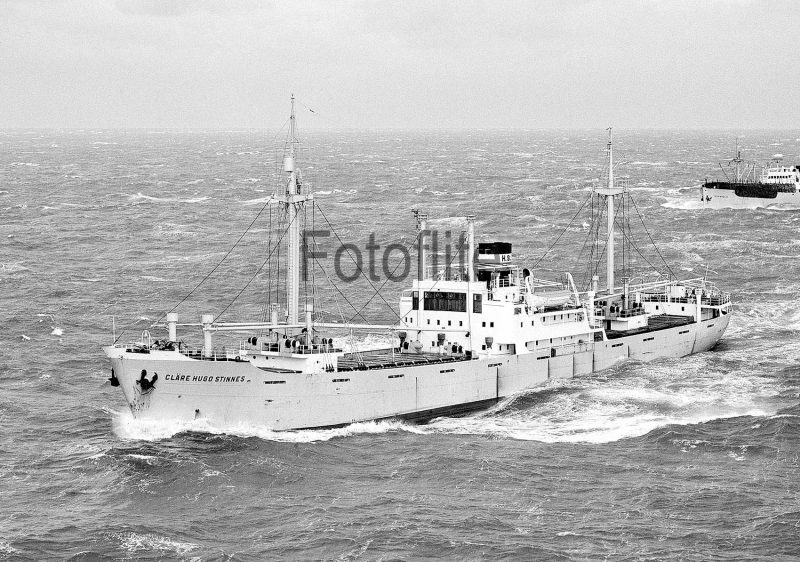
World War II
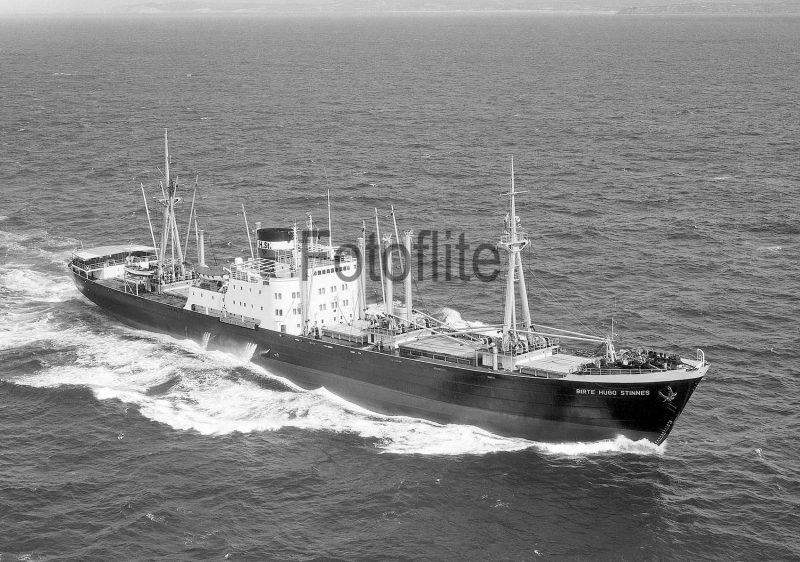
The total of ocean going vessels under Stinnes control of all of their subsidiaries numbered sixteen on the outbreak of war on 3rd September 1939, plus a fleet of smaller coastal and river craft. The motor tramp Johannes Molkenbuhr was scuttled on the day that war broke out, as she was intercepted off the Orkneys by a British destroyer while homeward bound, becoming the first of eleven Stinnes ships to be lost during the war. The majority of these losses occurred in Norway, which was invaded on 9th April 1940, with the far north of the country capitulating after a two month struggle against Norwegian and British forces. The ships lost were:-
- Clare Hugo Stinnes torpedoed and sunk on 2nd May 1940 off Bjornefjord
- Konigsberg-Preussen mined and sunk on 1st February 1941 off Cuxhaven
- Felix Heumann sunk by British destroyers during the Lofotens Raid on 3rd March 1941
- Ostpreussen torpedoed and sunk by British submarine Trident near Arnoy Island in the Norwegian Arctic on 22nd August 1941
- Rheinland had been seized by Netherlands at Padang in the Dutch East Indies on 10th May 1940 and renamed Berhala, but was torpedoed and sunk by U38 in convoy OB318 off Freetown on 23rd May 1941.
- Julius Hugo Stinnes mined and sunk on 10th September 1941 off Kolberg
- Welheim was sunk off Norway in November 1944
- Dieter Hugo Stinnes was mined and sunk on 16th February 1945 to north east of Swinemunde
- Else Hugo Stinnes was torpedoed and sunk by British aircraft on 4th May 1945 off Aro, raised and repaired and renamed Ruhr by Stinnes in 1947
- Ernst Hugo Stinnes was torpedoed and sunk by British aircraft on 4th May 1945 off Aro, raised and repaired and renamed Rhein by Stinnes in 1947
Three of the sextet of motor tramps built at Flensburg during 1936/39 survived the war to trade in post-war years for many years. Flensburg was bombed and sunk by British aircraft off Hela as Albert Jensen, but was raised and ceded to Russia and renamed Professor Popov, trading for three decades before being broken up. Mathias Stinnes was taken as a prize at Copenhagen in May 1945 and was ceded to Britain and renamed Empire Teviot. She became Akademik Krilov for Russia in 1946 and was broken up in Russia in 1975. Mulheim-Ruhr was taken over by the Norwegian Government in 1946 and renamed Falkenes, and traded until foundering in the South China Sea on 16th September 1966 after an engine room fire while on a voyage from Antwerp to Shanghai as Universal Pride. Masuren was taken as a prize at Copenhagen in May 1945 and ceded to Britain as Empire Annan, returning later to German owners as Fulsbuttel and was broken up at Bremerhaven in 1964 under that name. Poseidon was taken as a prize at Oslo in May 1945 and ended her days in Greece after being transferred to Greek owners in 1947.

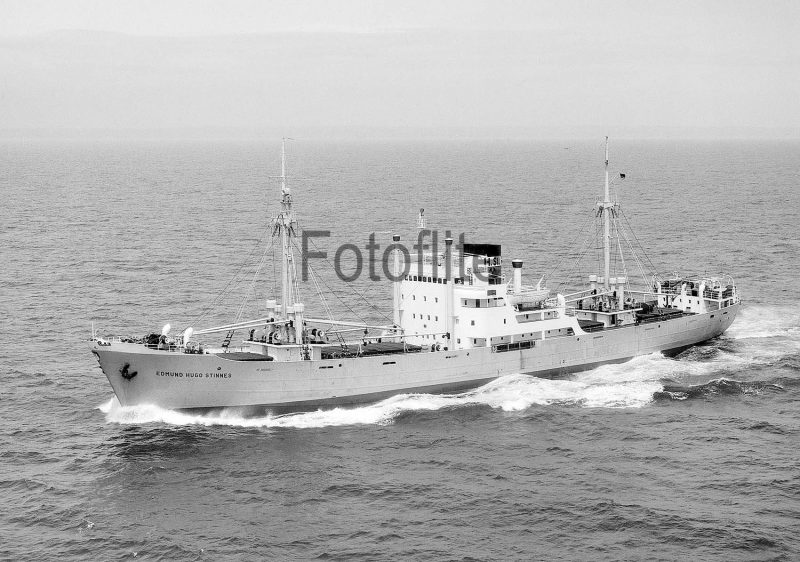
Post-War Years
At the end of the war, the Stinnes industrial empire of coal mines, iron and steel blast furnaces and the Brenstoff chemical plants lay in utter ruins, with the parent company of Hugo Stinnes A.G. confiscated by the occupation authorities and only a small branch company left in the hands of the Stinnes family. German shipping companies were not allowed to order construction of new deep sea ships until 1950. However, coastal coal shipments were allowed, and the Baltic coal trade was restarted in 1946 with the collier Utgard, and the Midgard Shipping Company A.G. based in Nordenham with a tug fleet could also operate. The American Government sent Dr. Heinz P. Kemper over to the Ruhr industrial area to begin reconstruction of the Mathias Stinnes Gmbh coking plants, briquette factories, iron and steel furnaces, and chemical and glass making factories. The Brennstoff company was renamed Brenntag A.G. while not under Stinnes family control during the time that Dr. Heinz P. Kemper was reconstituting the whole industrial heart of the Stinnes Group. In 1964, Hugo Stinnes A.G. repurchased Brenntag A.G. for 13 million deutschmarks.
The Poseidon Line and German Coal Depot fleet had by 1951 regained a size of over a dozen colliers, namely Annie Hugo Stinnes, Fritz Hugo Stinnes, Utgard, Artus, Asgard, Midgard, Poseidon, Rheinland, Vanguard, Rhein, Ruhr, and the new colliers Clare Hugo Stinnes 2,623/50 and Irmingard 2,465/51. Similar sized new colliers were completed in 1,952/53 as Andrea 2,960/52 and Barbara 2,990/53. The deep sea fleets were also revitalised in 1950 and big profits were made during the Korean War with cargoes of coal and steel to the U.S. Government. The new general cargo ship Westfalen of 6,000 dwt, and the second hand purchase of two old motorships from Axel Johnson of Sweden in Mulheim-Ruhr 3,696/15, the former three masted San Francisco, and Wolfsburg 5,504/19, the former three masted Balboa equipped with twin six cylinder Gotaverken diesel engines, were some of the ships of the new deep sea fleet.
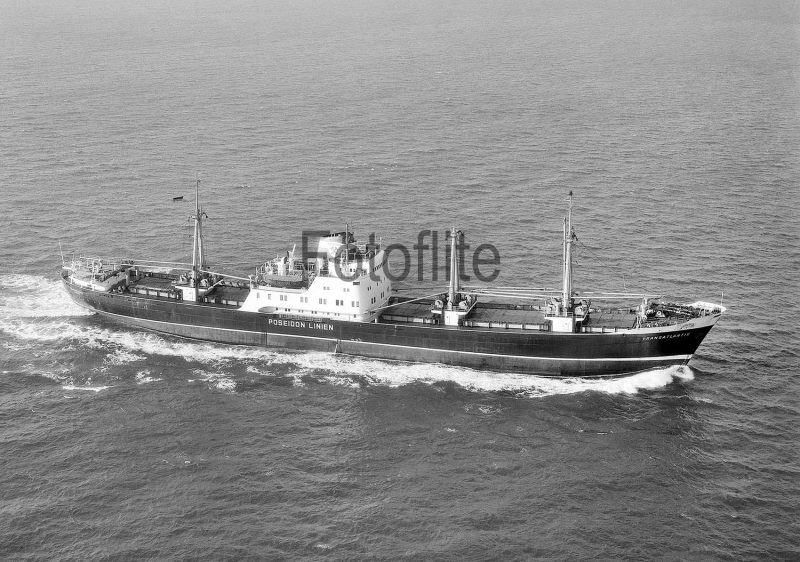
The former Morel of Cardiff tramp Nolisement of 9,150 dwt, built by the Northumberland Shipbuilding Co. Ltd. on the Tyne in 1928, was also purchased at this time and renamed Gluckauf. She was re-engined with twin nine cylinder diesel engines instead of her original quadruple steam reciprocating set, and rebuilt at the same time by the Howaldtswerke yard at Hamburg. She traded for Stinnes for seven years before being sold to Kvarneska Plovidba and renamed Kumrovec, and she arrived at Split for breaking up on 26th February 1966. Clare Hugo Stinnes of 1956 was sold to Ahrenkiel of Germany in 1964 and renamed Cimbria, before her sale to Pacific International Lines of Singapore in 1972 and renaming as Kota Menang. She ran aground on 10th August 1975 at Mombasa on a reef opposite the Nyali Beach Hotel while the guests were having breakfast. The pink bougainvillea and blue wisteria on the walls of the hotel contrasted with the nearby frantic efforts of the salvage team to refloat her. She broke her back eight days later but most of her Far Eastern cargo was salved.
The Transozean Schiffahrts Gmbh was formed in 1950 to trade to Canada and the U.S.A. on charter to their Stinnes Transocean subsidiary in the U.S.A. Several second hand motor vessels were used at first, including the three masted twin screw motorship Ostpreussen, built in 1914 by Burmeister and Wain at Copenhagen for Johnson Line as Kronprinsessan Margareta, and purchased in 1951 and lengthened in June 1952 to 8,195 dwt. She had her engines positioned almost right aft and gave another twelve years of service until broken up in 1963.
The new general cargo ship Birte Hugo Stinnes 8,500/53, named after the wife of Hugo Stinnes Junior, was followed by other similar ships of the same size e.g. Clare Hugo Stinnes of 13,480 dwt in 1956 from the Nordseewerke yard at Emden, and the engines aft bridge ‘midships Hugo Stinnes of 14,578 dwt in 1957 from the same yard. The latter ship was given a grey hull and twin bipod masts, and unusually was given a steam turbine set to give a service speed of 16.5 knots. In 1958, the former tanker Langanger of 14,510 dwt, built in 1930 for Westfal-Larsen of Bergen by the Robert Duncan & Co. Ltd. yard at Port Glasgow, was purchased and renamed Transozean Hugo Stinnes to import petroleum for the Stinnes oil subsidiaries and the Brenntag A.G. petrochemical subsidiary, which were sold off in 1963/64 to the Agip A.G. subsidiary of Italian oil company ENI.
Regular Poseidon Line Transatlantic Service
A regular Poseidon Line service to Canada from German and European ports was begun in 1950, with the ships employed on the service bearing ‘Poseidon Line’ in block letters on both sides of their hulls. The four hold open shelterdecker general cargo ship Poseidon of 10,040 dwt was completed in 1952 by the Lubecker Flender Werke yard at Lubeck for the service, with dimensions of 482.0 feet length, moulded beam of 59.9 feet and draft of 25.2 feet, and a heavy lift derrick on her foremast among many other small derricks, and a service speed of thirteen knots from a six cylinder Howaldtswerke diesel engine. All of the ships had accommodation for a dozen passengers, with ships transferred to the service from other Stinnes shipping companies, or purchased second hand or were newbuildings, all renamed with a ‘Trans’ prefix to their names. The ports of call of the summer service after the St. Lawrence Seaway opened in April 1959 were Hamburg, Bremerhaven, Rotterdam and/or Antwerp to Trois Rivieres, Montreal, Toronto, Cleveland, Toledo, Detroit, Milwaukee and Chicago.
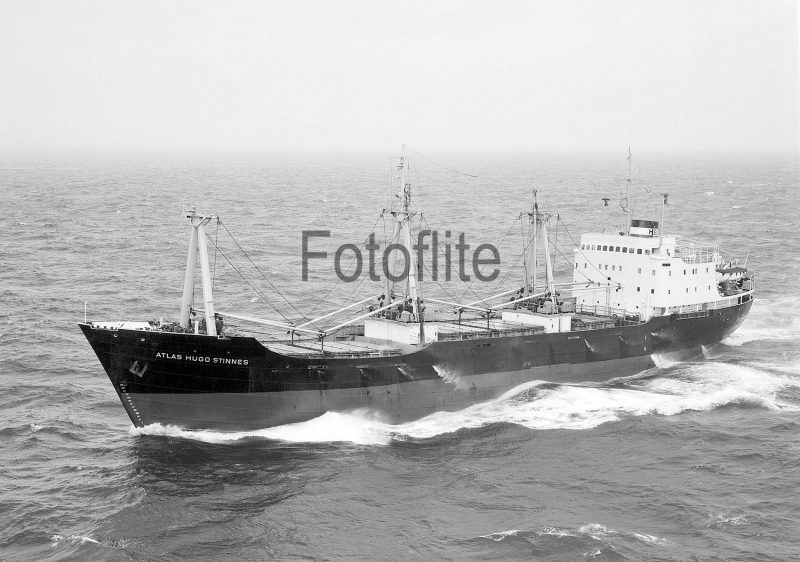
Transatlantic and Transamerica of 7,800 dwt were followed by the new Transpacific of the same size in 1954 from the Lubecker Flender Werke yard at Lubeck. Irmingard was renamed Transquebec in 1957, and the purchased twin screw motorship Yvonne was renamed Transcanada in the same year. The pre-war Olsen and Ugelstad motor vessels Makefjell and Harpefjell of 2,500 dwt were renamed Transmichigan and Transontario, and the Thor Dahl A/S cargo ship Thorstrand built in 1949 was renamed Transeuropa in 1961. Wellheim of 9,500 dwt and built in 1954 was renamed Transgermania in 1963, to give a six ship fleet employed on the service in 1966. In 1970, the Poseidon Line to Canada was modernised for container shipments with the new sisters Transamerica (2) and Transcanada (2) of 4,312 grt. The Baltic services of Poseidon Line were modernised at the same time with Transbaltica 2,326/72 and the coasters Transfinlandia and Translubeca, both 500/66. The Poseidon Line Great Lakes service ended towards the end of 1973, however the name of Poseidon Line continued in use outside of Stinnes control with ro-pax ferries named Transeuropa on the Baltic until they were sold off in 1999 to Finnlines of Helsinki.
A new era for Stinnes
The brothers Hugo Stinnes Junior and Otto Stinnes disagreed from 1953 onwards about the direction that the Stinnes shipping interests should take. They separated their interests in 1959, with Otto Stinnes taking the new bulker Mulheim-Ruhr of 16,419 dwt on a draft of 31.7 feet and completed in 1959 by the Lubecker Flenderwerke yard at Lubeck, as well as the smaller general cargo ships Kettwig 2,675/42 and Westfalen 6,530/56. Hugo Stinnes Junior had built up a large fleet from 1950 including the new Clare Hugo Stinnes of 1950 (renamed Else Hugo Stinnes in 1956 on the delivery of a larger motor vessel of the same name), Edmund Hugo Stinnes in 1953, Atlas Hugo Stinnes in 1955, Nora Hugo Stinnes in 1956, and the purchased Annie Hugo Stinnes (ex Ravnedal) in 1960. They were used on a West African service calling at Dakar, Conakry, Freetown, Monrovia, Lome, Cotonou, Lagos, Apapa, Douala, Libreville, Port Gentil and Pointe Noire. General cargo was carried outward with logs and African produce homeward.
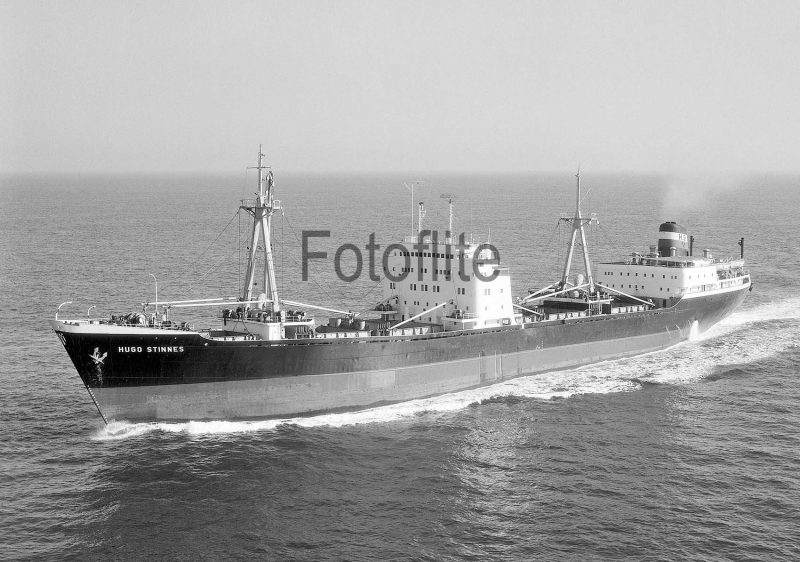
Four quarterdecker new sisters of 4,100 dwt were completed during 1960/63 for this West African service, named after companies in the Stinnes empire. Koholyt Hugo Stinnes, completed as Koholyt in November 1960, and Fella Hugo Stinnes in May 1962 from the Bremen Atlas yard, the shipyard that was owned by the Stinnes Group until 1964. The other new pair came from the Rheinstahl Nordseewerke yard at Emden as Mak Hugo Stinnes in September 1962 and Achgelis Hugo Stinnes in January 1963. Hugo Stinnes Junior unfortunately had to sell all of his ships at the end of 1963, and after clearing his debts he founded Seibert Stinnes Gmbh in 1967 based in Bremen with capital from Swiss investors. He then repurchased three of his quarterdeckers, namely Koholyt Hugo Stinnes, Mak Hugo Stinnes and Achgelis Hugo Stinnes.
Joint services were also operated in the 1960s from Hamburg to the U.S. Gulf with Ozean Line of H. Schult of Hamburg as Ozean-Stinnes Linien, with the vessels Niedersachsen and Barbara from Stinnes, and Hasselburg and Syllum from Ozean. A joint service by Ozean-Stinnes Linien, Hapag and NDL also operated with nine ships from Hamburg to Havana in Cuba and Vera Cruz in Mexico. Unfortunately, the whole of the Hugo Stinnes Transozean Schiffahrts Gmbh shipping empire failed financially on 12th March 1971.
Stinnes Zweigniederlassung
In 1976, the Hugo Stinnes A.G. group name was changed to Stinnes A.G. in recognition of the fact that the group was no longer in the hands of the Hugo Stinnes family, as 95% of the shares had been sold in 1965 to Veba A.G., the largest industrial group in Germany. The remaining 5% was acquired by Veba A.G. in 1992, and in return Veba A.G. sold its Rhine barge business to Stinnes in payment for the remaining Stinnes coal mines, glass works and chemical companies. At that point in time, Stinnes had returned to its roots and the Rhine barge businesses with which it had started in 1808.
A new Stinnes shipping subsidiary (Zweigniederlassung means subsidiary) was set up in 1972 by Otto Stinnes, brother of Hugo Stinnes Junior, to manage and operate bulkers and general cargo ships. Otto died in 1982 in the same year as his brother, and he passed the management of the healthy Stinnes shipping companies to his son Mathias, who continued to manage them until he sold them off in the early 1990s. The bulker Ravenna of 36,000 dwt was managed in 1972 for Singapore owners, and a new B430 type cargo ship fitted with derricks on four masts named Monsun of 11,900 dwt from the Warskiego yard in Szczecin in 1973 was purchased.
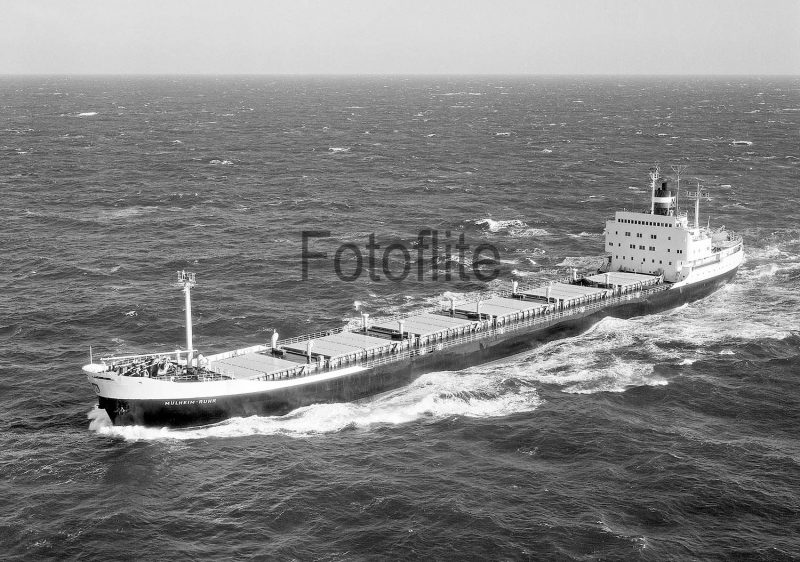
Monsun Shipping Gmbh was the name of a Stinnes shipping company set up in 1966. Monsun was taken on a three year charter by Elder, Dempster of Liverpool in 1976, and regained her name in 1979 and traded for ten more years until sold to French owners as Capitaine Quiros, and arrived for breaking up at Alang on 30th August 1996 under the name of Tanto Capitaine. The German ‘Liberty’ ship Passat of 15,900 dwt was owned and traded for four years from completion in 1973.
Three sister general cargo ships of 7,435 dwt from the Orenstein and Keppel yard in Lubeck in 1970/72 named Zephir, Taifun and Schirokko were owned from 1973. They were chartered out to container ship operators as the feeder container ships Hapag Lloyd Brasil and Nopal Pampero, and also gained a ‘Stinnes’ prefix on occasions as Stinnes Zephir, Stinnes Taifun and Stinnes Pampero. The sisters were equipped with a good set of cargo handling derricks on two masts and a goalpost mast in front of the bridge. Stinnes Pampero was the last ship operated of the trio when she was sold in August 1991, and Stinnes Zephir was in collision off Hakata on 6th June 1991 under the name of Pan Long and sank the following day. Stinnes Taifun was sold in 1989 and renamed Novseal and continued in service until she was reported missing on 6th February 2002 off Kochi in Western Japan while on a voyage from Weihei to Kashima with a cargo of 6,700 tonnes of sand and unfortunately her entire crew of nineteen were lost.
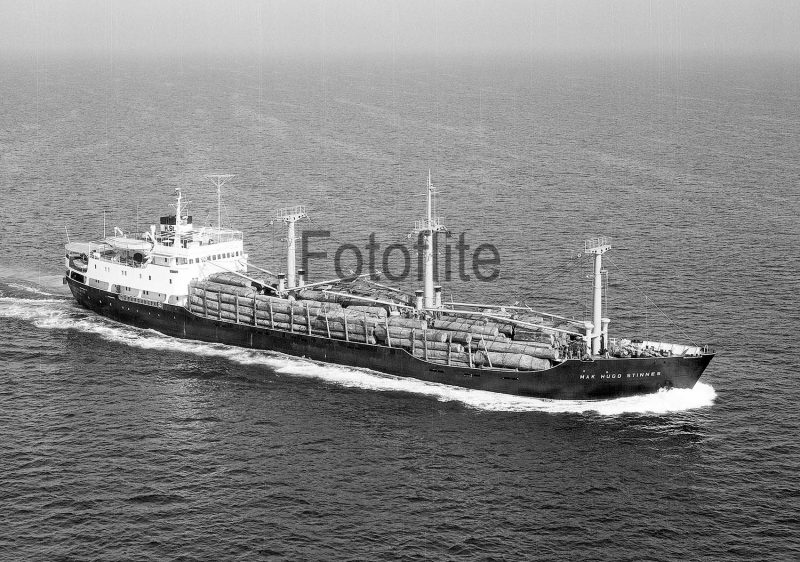
Two sisters of 10,800 dwt, built as Magdalena Wesch and Jonny Wesch in 1980 by the Howaldtswerke yard at Kiel for Jonny Wesch Gmbh of Jork, a small town on the left bank of the Elbe near Hamburg, were operated as Stinnes Bora and Stinnes Mistral in the late 1980s. They were fitted with a heavy lift Stulcken derrick of 180 tonnes capacity and four pedestal cranes of 16 tonnes capacity and could carry 590 TEU of containers. They operated as feeder container ships and were sold on to Cosco of China to operate in the same role as An Tao Jiang and An Wu Jiang respectively.
Stinnes began to operate a ro-ro service between Hamburg and the Tees in 1990 using the chartered vessel Maria S, and a consortium of Hamburg Sud, Stinnes, DSR, KNSL (Kenya National Shipping Line) and EAL (East African Lines) also began to operate a liner service to East African ports in the same year.
The DSR Type XD cargo ships Freyburg and Ronneburg built in 1968/69 were purchased for the East African service in February 1993 and renamed Pampero and Passat but were sold back to DSR eighteen months later. Andrew Weir Shipping (AWS) of Liverpool sold their Ellerman Line interests in an East African service to Hamburg Sud in May 2003, with Stinnes stepping in to plug the gap. Ships managed or chartered after the Millennium for the East African service included Tula of 17,438 dwt, an MPC Neptune 900 type, with a capacity for carrying 900 TEU of containers and equipped with three container handling cranes, which sailed from Hamburg and the Waalhaven in Rotterdam between 2003 and 2006. Stinnes vessels continued sailing to East Africa for a few more years until the consortium was abolished.
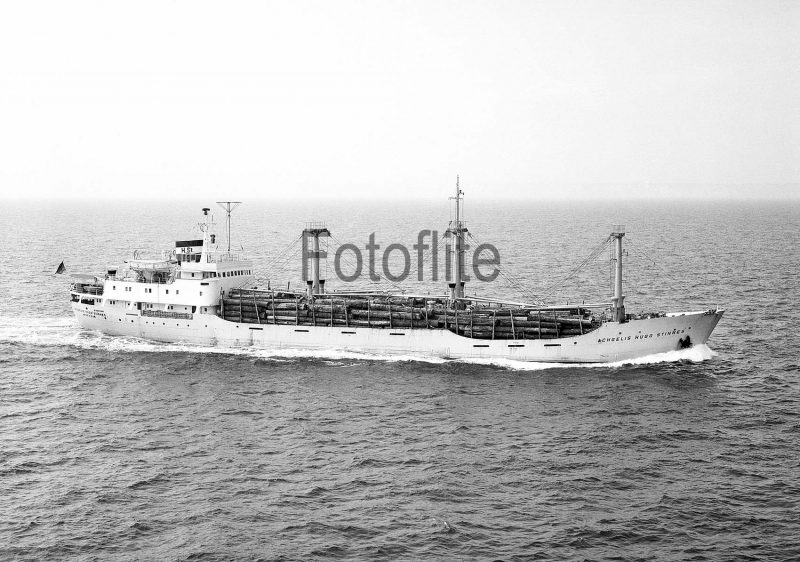
The last of the Stinnes Rhine dry cargo barges and tank barges, and the inland waterway shipping operation of RS Partnership, were sold off in 1998. The tugs of the Midgard Shipping Gmbh used at the only private port in Germany of Nordenham, Midgard I and Midgard II, were also sold off in 1998, Stinnes had taken over the port in 1911 and owned it until 1998. The Rhenus Division of Stinnes was also sold in March 1998 to the recycling company Rethmann A.G., the sale also included the inland shipping service of RS Partnership. Poseidon Shipping Gmbh, half owned by Stinnes and the German Coal Depot, had been sold in 1993 to Frachtcontor, a shipbroker and agency set up in 1905 by the German Coal Depot. The Danube Steamship Company with inland river services had been purchased in 1993 from the Austrian State, but was sold on again three years later after a severe fall in freight cargo along the Danube inland waterway. The Stinnes freight forwarding and logistics interests were the last Stinnes businesses and were finally sold to German State Railways in June 2004.
Today, Stinnes operates from its Head Office in Rostock as an independent shipping company focussed on two niche markets, a regular fortnightly liner service to Mexican ports using chartered Wagenborg vessels, and a weekly slot charter to South Africa on MSC container ships from Hamburg. The Mexican service operates from Hamburg, Bremen, Antwerp, Liverpool, Bilbao, Pasajes and Gijon in Spain and Aveiro in Portugal to Houston, Vera Cruz, and Tampico in Mexico. The Mexican service had been established in 1992 as a joint venture with DSR (Deutsche Seereederei Rostock) for a service to Caribbean and Mexican ports, and multi-purpose ships with heavy lift capability are regularly on charter with the names of Stinnes Mistral, Stinnes Passat, Stinnes Taifun and Stinnes Zephir. The South African slot charter service operates from Hamburg, Rotterdam, Antwerp, Felixstowe, London Gateway and Le Havre to Cape Town, Coega and Durban on a weekly service.

Postscript
Stinnes has been a well known and major name in German shipping for two hundred years, and continues to be very much in business with regular services from Hamburg and European ports to Mexico and South Africa. Hugo Dieter Stinnes was a very powerful yet controversial man in German shipping, industrial and political circles. An understanding of the Stinnes family and the part played by Clare Stinnes, the widow of Hugo Dieter Stinnes, and their sons Hugo Stinnes Junior and Otto Stinnes in managing the company is essential in following the Stinnes story through two hundred years of history. The large stone family tomb in Mulheim town cemetery reunites the three Stinnes generations of entrepreneurs in Hugo Hermann Stinnes, his son Hugo Dieter Stinnes, and his grandson Hugo Stinnes Junior.
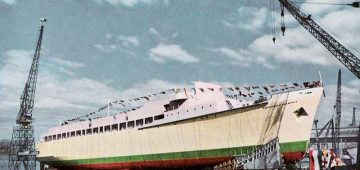
Comments
Sorry, comments are closed for this item